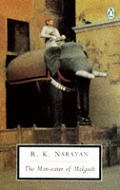Narayan, R.K. The Man-Eater of Malgudi. London: Heinemann, 1961.
 This novel was recommended to me by one of the authors reviewed below, who said it was a great book and that one of the central characters was a taxidermist. It’s true, or, at least the second half of the assertion is. The book starts off fascinatingly enough: Vasu, this taxidermist, appears one day in the shop of a small press operator (Nataraj, who narrates our tale) and uses weird persuasion and logic to practically force his way into living in the upstairs room. He’s a weird bully who never lays a hand on anyone, except of course the animals he kills.
This novel was recommended to me by one of the authors reviewed below, who said it was a great book and that one of the central characters was a taxidermist. It’s true, or, at least the second half of the assertion is. The book starts off fascinatingly enough: Vasu, this taxidermist, appears one day in the shop of a small press operator (Nataraj, who narrates our tale) and uses weird persuasion and logic to practically force his way into living in the upstairs room. He’s a weird bully who never lays a hand on anyone, except of course the animals he kills.But then much of this close-living, internal domestic conflict on a personal level turns into this grander-scale conflict on a societal level and I lost a lot of interest. Also, I’m teaching an intensive class these days, which left me with only twenty minutes here and there to read the book.
At any rate, two things were great. One is that Nataraj’s main friends are a poet and a journalist, who spend time in his parlor talking about the world they live in and what to write about it. The poet writes exclusively in monosyllables, which seems like an impossible thing to do, though I’m sure some Oulipo fancypants tackled it decades ago. I want desperately to read a lot of this. Nataraj says he “was thrilled to hear such clear lines as ‘Girls with girls did dance in trance’,” and I think this line roolz it, too. But what I especially like about all this is the dichotomy of poet and journalist. It’s better, somehow, than the poet/novelist one I used to spend time thinking about. They seem at such harsher odds with one another regarding what words should do.
The other great thing is this paragraph of Vasu’s:
‘Has it occurred to you how much more an elephant is worth dead? You don’t have to feed it in the first place. I can make ten thousand out of the parts of this elephant—the tusks, if my calculation is right, must weigh forty pounds, that’s eight hundred rupees. I have already an order for the legs, mounted as umbrella stands, and each hair on its tail can be sold for twelve annnas for rings and bangles; most women fancy them and it’s not for us to question their taste [ha! -ed.]. My first business will be to take out the hairs and keep them apart, while the blood is still hot; trunk, legs, even that nails—it’s a perfect animal in that way. Every bit of it is valuable. I’ve already several inquiries from France and Germany and from Hong Kong. What more can a man want? I could retire for a year on the proceeds of one elephant’ (132-3).Taxidermists turn animals into commodities, but then again, so very few hunt for the purposes of selling the mount. And even if they turn animals into commodities, aren’t the consumers, those people willing to buy any present-day equivalents of umbrella stands, also to blame? Do taxidermists (or did they) supply a demand that was already present, or did they create the demand for stuffed animals? I imagine the former; that post-Darwin, when natural history museums were booming and exhibiting specimens from around the world, people (men, really) decided, “Oh, well, I want that then, too.”
“Carcass” is like a portmanteau of “art” and “commerce”.


0 Comments:
Post a Comment
<< Home